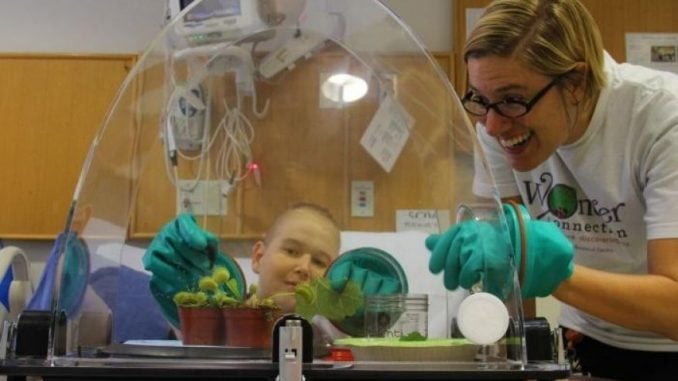
CHAPEL HILL At North Carolina Children’s Hospital, immune-compromised kids can experience the natural environment while getting around hospital rules digging in dirt, poking into pitcher plants and observing other wonders of nature otherwise prohibited thanks to a new device called the WonderSphere.The sealed chamber allows hospitalized kids and teens to reach inside, interact with nature, and enjoy scientific experimentation.”Nature has always been a source of refuge, hope and joy,” said Katie Stoudemire, founder of Wonder Connection, a program of the North Carolina Botanical Garden at the University of North Carolina at Chapel Hill.Stoudemire volunteered at children’s hospitals while completing her biology degree at North Carolina’s Davidson College, and it pained her to witness kids’ boredom and isolation from the environment.”I wanted to figure out a way to put things in a bubble, instead of putting kids in a bubble,” she explained. The certified science teacher started Wonder Connection in 2006 to provide science programming to hospitalized kids. That was around the time she had the idea of the WonderSphere.Stoudemire’s goal was to make activities more interactive, while safely bringing the outside in. She eventually took her brainstorm to the Philadelphia-based product design firm Bresslergroup. With grant funding from the Institute of Museum and Library Services and the North Carolina GlaxoSmithKline Foundation, the WonderSphere was created in 2015. This year, it won a national design award for social impact.Its airtight seal protects patients from materials that may host bacteria, viruses or fungi. The chamber comes with three pairs of built-in gloves for the patient, for Stoudemire and for a parent or sibling to participate, too.Essential to WonderSphere’s success: it fits on a hospital bed tray and is easily transported. Kids can see inside from any angle; the clear acrylic construction minimizes reflection and glare from harsh hospital lighting.As patients peer in, they can experiment with a smattering of specimens atop something akin to a lazy Susan.”We build in choice,” Stoudemire said, emphasizing the importance of extending options to kids during a time when they have few. Most hospital days are dictated by treatment regimens, doctor’s orders and hospital (and parent) rules. “First, I ask if they want to do science. Then, I ask what they want to do,” she explained.Playing with Venus fly traps is a popular selection, and budding scientists can enhance the lab experience with their own magnifying glass. Some kids cut through pitcher plant leaves to discover what the carnivorous species ingested. Junior archeologists can find ancient shark teeth and stingrays embedded in fossil dirt from eastern North Carolina mines.”She has done an awesome job of finding ways to have things previously not allowed in hospitals to be allowed in innovative ways,” said University of North Carolina pediatric psychologist Mary Beth Prieur.The rules were strict for 14-year-old Harrison McKinion of Raleigh when he first met Stoudemire in 2011. He had just started treatment for leukemia, and flowers and other deliveries were banned. But Harrison was able to participate in experiments with Wonder Connection. The high school freshman relapsed this summer, and the WonderSphere was a bright spot during a long two months as an inpatient.”He likes science,” said Harrison’s mother, Ginger. “If he was feeling just a bit bad, she would come in, he would perk up, and usually take her up on the offer.”Like many caregivers, she was glad when friends and teachers would visit Harrison; she could take a break. But when Stoudemire entered with the WonderSphere, Ginger stayed. “I was interested in what they were doing.”The impact of the dome on mental health, well-being and quality of life in the hospital has been tremendous, according to Prieur. “What is generally a mundane or frightful hospitalization can be brightened by these activities that are out of the box and ones they would not normally do in school,” she said. “I have seen kids who are more shy or feeling physically pretty poorly, and it brings them out of their shell. It gives them something to do in the day to distract them from being in the hospital and away from their friends.”



